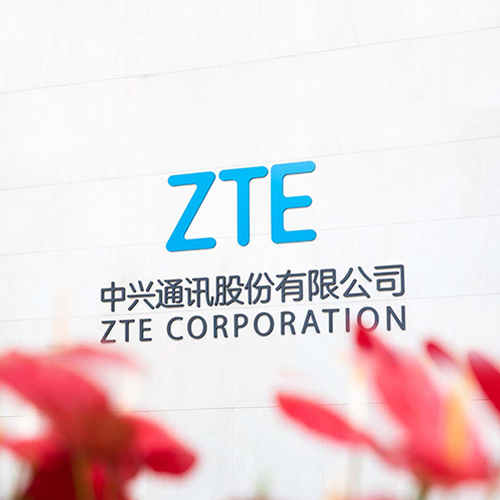
ZTE Chief Technology Officer
Wang Xiyu
19 February 2019, Shenzhen, China - ZTE Corporation (0763.HK / 000063.SZ), a major international provider of telecommunications, enterprise and consumer technology solutions for the Mobile Internet, today shared its insights into key issues of 5G development by Mr. Wang Xiyu, the Chief Technology Officer at ZTE. According to Mr. Wang Xiyu, the company has been committed to 5G technological innovation for digital transformation push.
In 2018, the 5G NR specifications were frozen. Many countries moved faster to allocate spectrum. Vendors had network product portfolios ready and started to launch commercial devices. Field trials were booming. Governments, operators, vendors, and vertical market companies were working together to accelerate 5G commercialization. Now, 5G is arriving while 4G is still flourishing. And 2019 will be the first year of 5G commercial deployments.
5G will definitely change all aspects of the world. But what would be the changes? How can ZTE maintain its leading position in 5G? What 5G product and solution portfolios does ZTE offer? In the wave of 5G, operators face many challenges in their digitization. How does ZTE become the best partner of operators?
Please refer to the below part for the detailed Q&A:
Q1: How do you think 5G will impact the society?
A: The 5G network will be 10 times faster than 4G and connect a massive number of things. Latency will decrease to 1ms, dozens of times less than that of 4G. As virtualization, cloudification, and AI technologies are introduced, the whole network will be more flexible and agile based on requirements. With the breakthrough in these capabilities and the adoption of AR, VR, and AI, 5G will advance the development of a comprehensive and intelligent ICT infrastructure that integrates communications, cloud, intelligence, and applications to drive the digitization of the world.
Firstly, there will be unlimited potential in new services like VR and AR, in new markets and applications like IoE and Industrial Internet, and in new business models. They will bring exciting user experience and encourage operators to refine their operations and create more value. They will also create more industry opportunities and boost related markets, which promote one another to form a positive cycle.
Secondly, 5G will empower the digitization of all industries directly. It will expand the capability boundaries of related industries and increase efficiency significantly, laying a solid foundation for industry upgrading.
In addition, the IoE in the 5G era will converge the virtual and physical worlds. It will enable real-time sensing and interactions of all things in the physical world and extensive AI applications. We will be able to make predictions and intervene before an event occurs rather than knowing about an event after it has happened, like in the Internet era.
ZTE has been working with operators and partners to demonstrate how 5G will empower traditional industries in vertical markets like new media, IoT, Internet of Vehicles, industrial Internet, smart grids, and smart cities. The demonstrations have shown the new capabilities of 5G. As commercial 5G networks are deployed, more innovative companies will leverage 5G networks to develop new services and models to meet the requirements of different industries.
Though 5G business models are still being explored, the requirements that drive the exploration are real, and the enabling technologies are solid. We believe that we will succeed in achieving the digitization of the whole society based on the 5G infrastructure.
Q2: How does ZTE ensure its leading position in 5G development?
A: The telecommunications industry has a high technology threshold, and telecommunications technologies have been evolving. To maintain competitiveness in this industry requires long-term accumulation of technologies and core capabilities, precise insights into tech trends, and a good understanding of the market. Over the past 30 years approximately, ZTE has adhered to customer requirements as the traction and to technology leadership. It is how ZTE ensures its leading position in 5G.
Adhering to customer requirements as the traction does not mean to meet any customer requirement. Only when the common pain points behind the requirements are discovered can we develop valuable solutions and lead the industry in innovation and development. In the past decades, ZTE has been focusing on attracting and developing a large number of technology talents. Meanwhile, ZTE has been following with markets closely and working closely with customers. Based on the precise insights on technology trends and customers’ common pain points, ZTE has launched many solutions that are leading in terms of innovation. For instance, ZTE’s SDR base stations help customers operate three generations of networks and evolve them continuously. ZTE’s UBR helps customers solve problems relating to antenna platforms and costs for multi-band base stations. Pre5G helps customers meet increasing data requirements prior to 5G deployment. Common Core helps customers get relieved from investment confusion when they experience 4G-to-5G evolution and virtualization. ZTE is able to support both 5G NSA and SA networks, but we suggest operators to choose SA, as it enables 5G networks to have better performance and service extension. The 5G SA networks feature a lower TCO of network building in the middle term and long term. They are also flexible in selecting suppliers. All of these will bring higher value to operators. Therefore, it is the focus on customer requirements and concerns that helps ZTE create higher value for customers and promote its own development.
Adhering to technology leadership helps ZTE outperform competitors and better meet customer requirements. The technology leadership can be illustrated from the aspects of infrastructural architectures, efficient delivery, core algorithms, and intelligent network O&M. In infrastructural architectures, ZTE’s core communications chipsets, including baseband, intermediate frequency, packet, and network processor chipsets, are based on advanced 7nm process. Their excellent performance facilitates 5G commercial deployment at low cost, low energy consumption, high quality, and large scale. They ensure leading product performance and smooth long-term evolution. In efficient delivery, based on agility and DevOps, Internet openness, and efficient process, the software architectures are becoming component-based, microservice based, virtualized, open and programmable. These facilitate rapid product delivery and address operators’ demand for cloud-based networks and open network ecosystems. In core algorithms, ZTE has over 30 years of experience in optimization of core algorithms for the physical, link, and network layers. Meanwhile, platform-based development helps grow such core capability and ensures the leading performance of customers’ networks. In intelligent network O&M, ZTE network intelligence solutions, based on ubiquitous AI, realize network resource optimization and failure prediction and analysis to increase efficiency and lower costs.
It is adhering to customer requirements as the traction and technology leadership that help ZTE increase its core competency and obtain a leading position in the 5G segment.
Q3:In the 5G era, what is ZTE’s strategy in product and solution portfolios?
A:ZTE focuses on end-to-end 5G solutions and has developed a full range of products, solutions, and services that cover five key areas, including 5G devices, RAN, bearer network, core network, and vertical applications. ZTE is a major provider of end-to-end 5G solutions in the industry.
ZTE has been developing technologies that are essential to 5G for many years. These technologies include Massive MIMO, NFV, end-to-end slicing, edge computing, AI, and cloud-network convergence. We have launched commercial end-to-end 5G product portfolios for all bands and scenarios.
In the area of RAN, ZTE has been leading in Massive MIMO technologies. We have over four years of experience in commercial deployments, with an accumulative number of shipment of over ten thousand sets. ZTE’s industry-leading multi-mode IT BBUs and a full range of RRU and AAU products for flexible combination can meet the requirements at different frequencies and in various scenarios.
In the area of 5GC, ZTE will be the first to launch the commercial version of a fully converged core network solution based on SBA. It will support 2/3/4/5G and fixed networks and thus increase network convergence and resource utilization.
In the area of 5G transport network, ZTE was the first to offer a unified solution for 5G fronthaul, mid-haul, and backhaul. It is leading the industry in FWA, ultra-wide pipe, elastic network slicing, lowest latency, ultra-high reliability, and high-precision time synchronization. This solution helps customers build super-fast, intelligent, and converged 5G transport networks. TITAN, ZTE’s new-generation flagship optical access platform developed for 5G and network re-architecture, has been commercialized in many countries across the world.
In the area of devices, ZTE will launch its commercial 5G mobile phones in the first half of 2019. ZTE is also developing 5G tablets, in-door/outdoor CPEs, hotspots, data terminals, and other 5G products, to meet different consumers’ requirements.
In the area of self-developing chipsets, ZTE has developed and produced at scale over 100 types of chipsets for over two decades, covering transport, access, and terminal areas. Its latest multi-mode chipsets support all of the current 5G specifications and realize the convergence of 2/3/4/5G. To save energy, ZTE adopts advanced processes, new materials, and new architectures of essential chipsets to lower energy consumption and increase power and PA efficiency. In combination with network optimization such as intelligent network shutdown, ZTE’s solutions help operators reduce OPEX.
In the area of consumer applications, ZTE is working with operators to carry out 5G-based big video service pilot programs. ZTE is also collaborating with operators and partners to demonstrate how 5G will empower traditional industries in vertical markets like new media, IoT, Internet of Vehicles, Industrial Internet, smart grids, and smart cities.
Q4: As operators are undertaking digitization, how can ZTE be their best partner?
A: Operators have notable advantages in the process of digitization. They have extensive offline service networks to serve households and enterprises. They have high credibility, which is a natural quality for B2B services. Their infrastructures are the first interface with clients.
To better serve clients’ digitization, operators need to first increase their network agility, resource scheduling flexibility, and network scalability so as to enable their networks to support diversified and customized services. ZTE provides SDN/NFV products that are based on mainstream technologies and provide telecoms reliability and high performance to help operators make their network agile.
As the operators are in different stages of digitization, some operators have not completed the digital transformation of their own operations, so they are facing challenges in response to the digitization of the society. ZTE has rich experience in its own digitization and provides national data platforms, ICT PaaS, distributed databases, and other fundamental software for large operators. ZTE is able to help operators achieve their own digitization.
When extending business, operators need to accumulate experience and integrate capabilities of partners to offer clients solutions with the best technologies, the lowest costs, and the optimal delivery. As a long-term strategic partner of operators, ZTE has required capabilities relating to video, AI, fundamental software, and device development. ZTE is willing to work closely with global operators to offer the best solutions for customers’ digitization.
